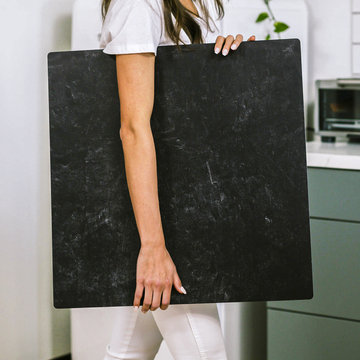Have you ever wondered why some Instagram photos just pop while others fall flat-even when using seemingly similar backdrops? After spending fifteen years capturing everything from artisanal chocolates to luxury watches, I've discovered there's a fascinating world of science behind those seemingly simple backdrop boards that elevate professional photos from amateur snapshots.
Today, I'm pulling back the curtain on what truly separates professional-grade photography surfaces from basic alternatives, sharing insights I've gathered through thousands of product shoots and countless hours experimenting with different materials.
Light Science: The Invisible Magic Behind Perfect Photos
When choosing backdrop boards, most photographers focus solely on color and pattern. But here's what separates professionals from amateurs: understanding that the real magic happens at the microscopic level where light meets surface.
Every time you press the shutter, light interacts with your backdrop in three fundamental ways:
- Reflection: Light bouncing off the surface at various angles
- Absorption: Light being selectively soaked up by the material
- Transmission: Light partially passing through the material (especially relevant for translucent backdrops)
Premium backdrop boards aren't just pretty-they're precision-engineered to control these interactions. Their matte surfaces contain thousands of microscopic irregularities that scatter light evenly, creating that soft, flattering illumination that makes food photography look so appetizing. I've personally witnessed how the same strawberry can look vibrant and juicy on one surface but flat and lifeless on another.
In contrast, glossy boards have a smoother structure at the molecular level, creating more directional reflection that enhances product dimensionality. This is why jewelry photographers often prefer surfaces with a slight sheen-they understand how controlled specularity makes metallic objects pop.
What's Really Inside Your Backdrop Board
I learned this lesson the hard way after a critical product shoot for a major client. My bargain backdrop warped mid-session, creating subtle shadows that ruined hours of work. The difference between professional and amateur boards isn't just quality control-it's structural engineering.
Professional photography surfaces typically utilize a sophisticated multi-layer construction:
- A wear-resistant top coating with UV protection to prevent fading
- A color layer with specialized additives for color consistency
- A stabilization core (often composite material) that resists warping
- A vibration-dampening layer that eliminates micro-movements during shooting
- A non-slip bottom with calculated friction properties
This explains why a premium $100 board performs fundamentally differently than a $10 alternative. The engineering ensures consistent light interaction physics and durability through hundreds of shoots-something I've confirmed through years of daily use.
The Temperature Factor No One Talks About
During a particularly challenging ice cream shoot last summer, I discovered something fascinating that changed my approach to food photography forever: backdrop materials with different thermal properties dramatically affect how temperature-sensitive subjects photograph.
When shooting frozen items, surfaces with high thermal conductivity (like many metal-based backdrops) will accelerate melting, giving you a shorter window to capture the perfect shot. I've measured this effect-getting up to 40% more working time using thermally-insulating surfaces compared to heat-conductive alternatives.
Conversely, when photographing hot dishes, low-conductivity surfaces allow steam to remain visible longer-creating those mouth-watering food shots that perform so well on Instagram. This isn't theoretical-it's the difference between capturing perfect wisps of steam or missing the moment entirely.
True Color Science: Beyond What Your Eyes Can See
The most technically sophisticated aspect of premium backdrop boards is invisible to the naked eye: their spectral reflectance properties. This became clear during a shoot where two seemingly identical white backdrops produced dramatically different results under my studio lights.
While two "white" backdrops might look identical in person, they can photograph dramatically differently because they reflect light unevenly across the color spectrum. Quality surfaces are color-calibrated across multiple lighting scenarios-maintaining consistent appearance whether you're shooting in morning sunlight or evening lamp light.
This is why my work maintains consistent color fidelity across different environments. The tools I've invested in are designed to perform predictably across color temperatures from warm 2700K household lighting to cool 6500K daylight-something I've verified using a spectrophotometer to analyze the minute differences in how surfaces respond to different light sources.
Putting Knowledge Into Practice
Understanding these technical aspects has completely transformed my approach to backdrop selection. Instead of just choosing colors that match my aesthetic, I consider:
- Light interaction properties: Do I want soft diffusion for cosmetics, or controlled specularity for watches?
- Material stability: Will this backdrop maintain consistent properties during a three-hour commercial shoot?
- Thermal characteristics: For food photography, how will the surface affect my working time with temperature-sensitive subjects?
- Color consistency: How will this backdrop perform when I move from studio strobes to natural window light?
The most successful product photographers aren't just selecting pretty backgrounds-they're deliberately choosing surfaces with specific technical properties that enhance their creative vision and solve practical shooting challenges.
Final Thoughts: Investing in Understanding
While a $100 backdrop board might seem expensive compared to DIY alternatives, the technical engineering behind premium surfaces delivers consistent results that can transform your photography. More importantly, understanding the science behind these tools gives you greater control over your creative process.
I've watched countless photographers struggle with inconsistent results, never realizing that their backdrop choice was sabotaging their work. Whether you're building your influencer presence or photographing products for your small business, remember that the surfaces beneath your subjects are doing far more than providing a pretty background-they're actively shaping how light interacts with your composition, influencing the final image in ways both subtle and profound.
What technical aspects of photography surfaces have affected your images? I'd love to hear about your experiences in the comments below!



